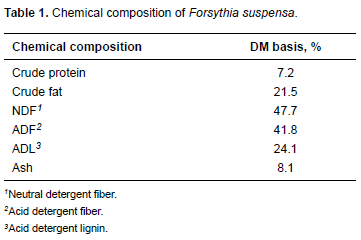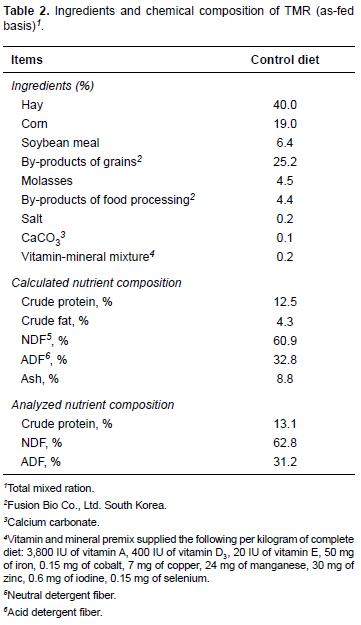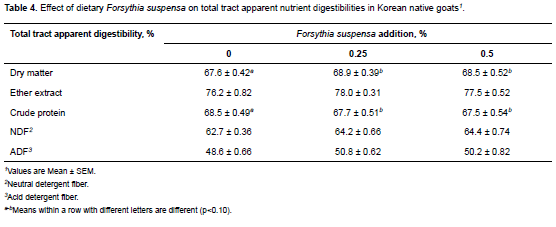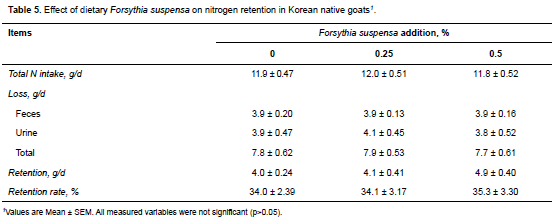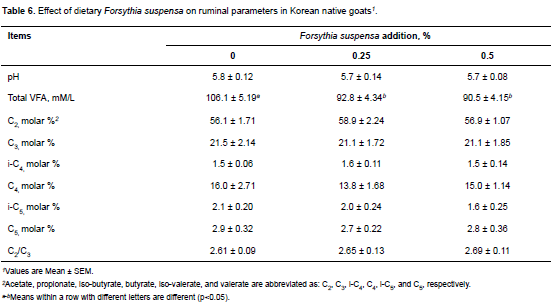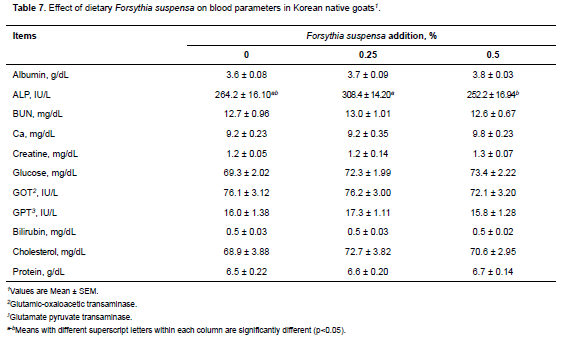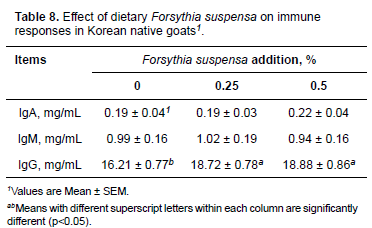Services on Demand
Journal
Article
Indicators
-
 Cited by SciELO
Cited by SciELO -
 Access statistics
Access statistics
Related links
-
 Cited by Google
Cited by Google -
 Similars in
SciELO
Similars in
SciELO -
 Similars in Google
Similars in Google
Share
Revista Colombiana de Ciencias Pecuarias
Print version ISSN 0120-0690
Rev Colom Cienc Pecua vol.28 no.2 Medellín Apr./June 2015
https://doi.org/10.17533/udea.rccp.v28n2a05
ORIGINAL ARTICLE
doi: 10.17533/udea.rccp.v28n2a05
Effects of dietary Forsythia suspensa on feed utilization, rumen fermentation, and immune response of Korean native goats (Capra hircus)¤
Efectos de la adición dietaria de Forsythia suspensa sobre utilización del alimento, fermentación ruminal y respuesta inmune en cabras nativas coreanas (Capra hircus)
Efeitos na dieta pela utilização de Forsythia suspensa nos alimentos, fermentação ruminal e resposta imune em caprinos nativos coreanos (Capra hircus)
No Seong Park1, BSc, MSc; Chi Hyun Cho1, BSc, MSc; Jung Min Heo1, BSc, PhD; Minho Song1, BSc, PhD; Byung Mo Yang1, BSc; Hyung Suk Lee2, BSc, PhD; Soo Kee Lee1*, BSc, PhD.
1Department of Animal Science and Biotechnology, Chungnam National University, Daejeon 305-764, South Korea.
2Department of Pet-animal Science, Woosong Information College, Daejeon 300-715, South Korea.
*Corresponding author: Soo Kee Lee. Department of Animal Science and Biotechnology, Chungnam National University, Daejeon 305-764, South Korea. Tel: 82-42-821-5775, Fax: 82-42-825-9754. Email: leesk@cnu.ac.kr
Received: September 2, 2013; accepted: April 26, 2014
Summary
Background: plant extracts of Forsythia suspensa, which contain pinoresinol, have been proposed as an alternative to antibiotics due to their antioxidant, anti-inflammatory, and microflora modulating effects. Objective: to evaluate the effects of dietary F. suspensa on feed utilization, rumen fermentation, blood parameters and immune response of Korean native goats (Capra hircus). Methods: a total of nine Korean native goats were assigned to one of three dietary treatments: 1) a basal diet without F. suspensa, 2) a basal diet added with 0.25% F. suspensa, or 3) a basal diet added with 0.50% F. suspensa. A change-over design was used in three consecutive periods to give 9 replicates per treatment. Each period lasted 18 days, including 15 days of adaptation to feed and environmental conditions and three days of total collection of feces and urine. Rumen fluid and blood samples were also collected. Nutrient digestibility, nitrogen retention, ruminal content, and blood metabolites—including immunoglobulins—were measured. Results: F. suspensa supplementation had no effect on nutrient digestibility, whole body nitrogen retention rate, ruminal pH, acetate, propionate, isobutyrate, butyrate, isovalerate, or valerate content (p>0.05). However, F. suspensa supplementation decreased total volatile fatty acids (VFA) concentration compared with the control diet, regardless of F. suspensa concentrations (p<0.05). Goats fed a diet containing 0.25% F. suspensa had greater alkaline phosphatase (ALP) concentration than those fed a control or a diet with 0.50% F. suspensa (p<0.05). Feeding different concentrations of dietary F. suspensa did not influence plasma IgA and IgM levels (p>0.05), although goats receiving both 0.25% and 0.50% F. suspensa diets had greater plasma IgG than those fed the control diet (p<0.05). Conclusion: supplementation of 0.25% F. suspensa significantly decreased total VFA concentrations and increased plasma IgG in Korean native goats, compared with those fed the control diet.
Keywords: antibiotic replacement, immunoglobulin, plant extract.
Resumen
Antecedentes: los extractos de la planta Forsythia suspensa contienen pinoresinol. Dicha planta se ha propuesto como una alternativa a los antibióticos debido a su contenido de antioxidantes, antiinflamatorios y sus efectos moduladores de la microflora. Objetivo: evaluar los efectos dietarios de F. suspensa sobre la utilización del alimento, fermentación ruminal, parámetros sanguíneos y respuesta inmune en cabras nativas coreanas (Capra hircus). Métodos: un total de nueve cabras nativas coreanas fueron asignadas a 1 de 3 tratamientos: (1) una dieta basal sin F. suspensa, (2) una dieta basal con 0,25%, o (3) 0,50% de F. suspensa dietaría en un diseño change-over por tres periodos consecutivos con nueve réplicas por tratamiento. Cada periodo se prolongó por 18 días, incluyendo 15 días de adaptación al alimento y a las condiciones ambientales, y tres días de colección total de heces y orina. Tambien se colectó fluido ruminal y muestras sanguineas. Se midió la digestibilidad de nutrientes, nitrógeno retenido, contenido ruminal y metabolitos sanguíneos —incluyendo inmunoglobulinas—. Resultados: la suplementación con F. suspensa no tuvo efecto sobre la digestibilidad de los nutrientes, la tasa de retención de N, pH ruminal, ni sobre los contenidos de acetato, propionato, isobutirato, butirato, isovalerato o valerato (p>0,05). Sin embargo, la suplementación con F. suspensa disminuyo la concentración total de ácidos grasos volátiles (VFA) en comparacion con la dieta control, sin tener en cuenta las concentraciones de F. suspensa (p<0,05). Las cabras alimentadas con la dieta de 0,25% de F. suspensa tuvieron mayor concentración de fosfatasa alcalina (ALP) que cuando fueron alimentadas con la dieta control o con la de 0,50% de F. suspensa (p<0,05). Aunque la alimentación con diferentes concentraciones de F. suspensa no influyo en los niveles de IgA y IgM en plasma (p>0,05), las cabras que recibieron 0,25 y 0,50% de F. suspensa tuvieron mayor concentración de IgG en plasma que aquellas alimentadas con la dieta control (p<0,05). Conclusiones: la suplementación de 0,25% de F. suspensa disminuyo significativamente la concentración total de VFA e incrementó la IgG en el plasma de las cabras nativas coreanas, en comparación con aquellas que consumieron la dieta control.
Palabras clave: extracto de planta, inmunoglobulina, reemplazo de antibióticos.
Resumo
Antecedentes: a Forsythiae suspensa é uma planta e seu extrato contém pinoresinol. Tem sido proposta como uma alternativa aos antibióticos existentes, devido ao seu teor de antioxidantes, anti-inflamatórias e efeitos moduladores da microflora, com base em estudos feitos in vivo e in vitro. Objetivo: avaliar os efeitos na dieta da inclusão de F. suspensa no aproveitamento alimentar, fermentação ruminal, parâmetros sanguíneos e resposta imune em caprinos coreanos nativos (Capra hircus). Métodos: um total de nove cabras coreanas nativas foram assignadas a um de três tratamentos na dieta: (1) uma dieta basal sem F. suspensa, (2) uma dieta basal com 0,25% de F. suspensa, ou (3) com 0,50% de F. suspensa na dieta. Se fez um desenho change-over por três períodos consecutivos com nove repetições por tratamento. Cada período de pesquisa consistiu de 18 dias, incluindo 15 dias de adaptação às condições alimentares e ambientais, e três dias de coleta total de fezes e urina. Também foram coletadas amostras de líquido ruminal e sangue. Mediou-se a digestibilidade dos nutrientes, o nitrogênio (N) retido, o conteúdo ruminal, e os parâmetros sanguíneos —incluindo imunoglobulinas—. Resultados: a suplementação com F. suspensa não teve nenhum efeito sobre a digestibilidade dos nutrientes, a taxa de retenção de N, o pH do rúmen, nem sobre os conteúdos de: acetato, propionato, isobutirato, butirato, isovalerato e valerato (p>0,05). No entanto, a suplementação de F. suspensa diminuiu a concentração total de ácidos gordurosos voláteis (AGV) em comparação com a dieta controle, independentemente das concentrações de F. suspensa (p<0,05). As cabras alimentadas com 0,25% F. suspensa na dieta tiveram maiores quantidades da enzima fosfatasse alcalina (ALP) do que quando elas foram alimentadas com a dieta controle ou com 0,50% de F. suspensa (p<0,05). Ainda que a alimentação com diferentes níveis de F. suspensa não influenciou os níveis de IgA e IgM no plasma (p>0,05), as cabras que receberam na dieta 0,25 e 0,50% de F. suspensa tiveram uma maior concentração de IgG no plasma comparadas as cabras alimentadas com a dieta controle (p<0,05). Conclusões: a suplementação com 0,25% e 50% diminuiu significativamente a concentração de AGV e incrementou a concentração em plasma de IgG em cabras nativas coreanas comparadas com aquelas que consumiram a dieta controle.
Palavras chave: extrato de planta, imunoglobulina, uso alternativo de antibióticos.
Introduction
Plants produce a huge variety of secondary compounds for protection against microbial and insect attacks (Wallace, 2004). Some of these compounds, such as essential oils (Patra et al., 2006; Yang et al., 2007; Agarwal et al., 2009; Sallam et al., 2009; Wang et al., 2009a), saponins (Lovett et al., 2006; Pen et al., 2007; Singer et al., 2008; Mao et al., 2010), tannins (Hervas et al., 2003; Mueller-Harvey, 2006; Beauchemin et al., 2007; Waghorn, 2008), and organosulfurs (Bampidis et al., 2005; Yang et al., 2007) are used as dietary additives to selectively modulate rumen microbial populations, improve nitrogen metabolism and decrease methane production in the rumen. Overall ecology modulation of rumen microflora can also influence the gastrointestinal health of the host animal. Several experiments showed Forsythia fructus has antioxidant effects in rats (Lu et al., 2010), in vitro anti-inflammatory effects (Lim et al., 2008), in vitro prevention of unfavorablemicroorganisms (Bae et al., 2005; Qu et al., 2012), effects against allergic reactions to soybeans in weaned pigs (Hao et al., 2010), and can regulate blood pressure in rabbits (Moon and Ha, 1977).
However, there is little information available about the effects of F. fructus or Forsythia suspensa supplementation on ruminants. Therefore, the objective of this study was to evaluate the effects of dietary F. suspensa on feed utilization, rumen fermentation, blood parameters, and immune responses in Korean native goats.
Material and methods
The experimental protocol used in this study was approved by the Animal Care and Use Committee of Chungnam National University in South Korea.
A total of nine Korean native goats (average body weight: 26.1 ± 0.42 kg) were used. Goats were individually housed in metabolism crates (50 cm × 100 cm × 70 cm). Crates were equipped with wiremesh flooring, a nipple drinker and a metal feeder. Goats had ad libitum access to water and experimental diets throughout the experiment. Diets were fed as a total mixed ration (TMR). The test supplement (i.e., F. suspensa) was ground using a laboratory hammer mill (Glen Creston Ltd., London, UK) through a 1 mm screen before top-dressed to the control TMR. Experimental diets were formulated to meet or exceed nutrient requirements of goats (NRC, 1985). Composition and nutrient contents of the experimental diets are presented in Tables 1 and 2. The experiment was conducted as a change-over design with three consecutive periods and nine observations per treatment. Goats were fed once per day (0900 h) to meet or exceed daily energy requirements based on body weight. Each period lasted 18 days, including 15 days of adaptation to feed and environmental conditions, and 3 days of total collection of feces and urine. The ambient temperature was maintained at 25 °C to 30 °C throughout the study. Feed and water intake were measured daily. Fecal samples were collected daily in sample bags and immediately stored at -20 ºC for further analysis. Urine was collected daily in sample containers added with 50 mL HCl (10%, v/v) to minimize N losses. Urine was weighed and a sub-sample (10% of the total weight) was strained through glass wool and stored at -20 °C.
Fecal samples were thawed and pooled for each goat in each period, then subsampled and oven dried. The dried samples of feces and diet were ground with a laboratory hammer mill (through 1 mm screen; Glen Creston Ltd., London, UK) and thoroughly mixed prior to chemical analysis. Fecal and diet samples were analyzed for DM, ether extract, nitrogen (N), neutral detergent fiber (NDF), and acid detergent fiber (ADF). Dry matter was determined according to the method of AOAC (1990; method925.09). Nitrogen content was determined by combustion (method 990.03; AOAC 1990) using a combustion analyzer (model CNC-2000; Leco Corporation, St. Joseph, MI, USA). Ether extract was determined using the AOAC method920.39 (1990). NDF and ADF content were analyzed according to the method of Goring and Van Soest (1970). Total tract apparent digestibility (TTAD) was calculated using the following equation [(nutrient intake - fecal excretion)/nutrient intake] x 100.
Rumen fluid was collected using a stomach tube 2 h prior to daily feeding. Rumen contents were filtered through four layers of cheesecloth and pH was immediately determined using a pH electrode (pH meter 440, Corning, NY, USA). Volatile fatty acid (VFA) concentrations were determined in duplicate samples using methods described by Fenner and Elliot (1963).
Blood samples were collected from the jugular vein in heparinized vacuum tubes (BD Vacutainer, Becton, Dickinson and Company, NJ, USA) before the morning feeding at the end of each experimental period. Samples were immediately centrifuged at 2000 × g for 30 min, and plasma was stored at -70 ºC until analysis. Plasma samples were analyzed using an automatic analyzer (SPOTCHEM EZ SP-4430, Arkray Inc., Kyoto, Japan) to measure albumin, alkaline phosphatase (ALP), blood urea nitrogen (BUN), calcium (Ca), creatine, glucose, glutamic-oxaloacetic transaminase (GOT), glutamate pyruvate transaminase (GPT), total Bilirubin, total cholesterol, and total protein. Plasma IgA, IgM, and IgG were measured using commercially available ELISA kits (Blue Gene Biotech Co. Ltd., Shanghai, China). Goat plasma was dispensed in each well and incubated together with IgA, M and G-HRP conjugate in a precoated plate at 37 ºC for 1 h. Thereafter, the plates were decanted and washed five times with washing solution, and then substrate solutions were added and kept at 37 ºC for 15 min. Finally, a stop solution was added to the reaction and measured at 450 nm in a microplate reader (Thermo-Max, Molecular Devices, Sunnyvale, CA, USA).
Data were analyzed using the GLM procedure of ANOVA (SAS software release 9.1, SAS Inst. Inc., Cary, NC, USA). Individual goats were the experimental unit for all measured variables. Pairwise comparisons between means were made when appropriate using Fisher's-protected LSD analysis when a significant treatment effect was observed. Statistical significance and tendency were considered at p<0.05 and 0.05≤p<0.10, respectively.
Results
Dietary treatments had no effects (p>0.05) on feed or water intakes, nor on urine, or feces excretion (Table 3).
Supplementation of F. suspensa tended to increase total tract apparent digestibility of dry matter (p<0.10), while total tract apparent crude protein digestibility tended to decrease with F. suspensa supplementation (Table 4).
No effects were observed of F. suspensa addition on total N intake and excretion through feces and urine, N retention, or whole body N retention rate (Table 5).
F. suspensa supplementation decreased (p<0.05) total VFA concentration in ruminal digesta compared with the control diet, regardless of F. suspensa concentrations (Table 6). However, ruminal pH, acetate, propionate, iso-butyrate, butyrate, iso-valerate, and valerate contents, and acetate:propionate ratio were not affected (p>0.05) by different concentrations of dietary F. suspensa supplementation (Table 6).
Goats fed the 0.25% F. suspensa diet had greater (p<0.05) ALP concentration than those fed the control or 0.50% F. suspensa diet (Table 7). Nonetheless, dietary treatments had no effect (p>0.05) on blood parameters such as albumin, BUN, Ca, creatine, glucose, GOT, GPT, total bilirubin, total cholesterol, and total protein (Table 7). Although feeding different concentrations of dietary F. suspensa did not influence (p>0.05) plasma IgA and IgM contents, goats receiving both 0.25% and 0.50% F. suspensa had greater (p<0.05) plasma IgG than those fed the control diet (Table 8).
Discussion
The main purpose of this study was to determine whether supplementation of either 0.25% or 0.50% F. suspensa alters total tract apparent digestibility, rumen fermentation, and immune response in Korean native goats. There are increasing concerns associated with the use of antimicrobial compounds in animal feed due to possible transfer of antibiotic resistance to humans. F. suspensa has been proposed as a possible alternative to antimicrobial compounds along with other plant extracts.
No dietary effects were observed on feed intake, water consumption, urine, or feces excretion in the current study. This indicates that F. suspensa odor does not affect diet palatability. According to Devendra and Burns (1983), feed intake by goats varies from 1.7% to 4.8% of the body weight, depending on the breed, which is in agreement with our result. In addition, there were no effects of dietary treatments on water or dry matter intake. According to Silanikove (1992), water intake is closely related to DM intake. There was no significant difference in urine or feces output, and this appears to be due to intake of feed and water.
No significant differences were found on digestibility of dry matter, crude protein, crude fat, NDF, or ADF in response to dietary supplementation of F. suspensa. There is limited evidence showing a relationship between F. suspensa supplementation and total tract apparent nutrient digestibility in ruminants. However, F. suspensa triterpenes may affect nutrient digestibility. Although Pen et al. (2007) reported that supplementation of Yucca schidigera or Quillaja saponaria extracts containing triterpenes did not alter total tract apparent nutrient digestibility, it decreased upon supplementation of an extract containing triterpene (Holtshausen et al., 2009). On the other hand, high fiber and lignin contents in the plant extract are known to affect total tract apparent nutrient digestibility in ruminants. For example, Mekasha et al. (2002) reported that high fiber and lignin diets decrease nutrient digestibility. However, despite the high lignin in F. suspensa (24.1%), F. suspensa supplementation up to 0.5% did not affect total tract apparent nutrient digestibility in this study.
No effects of F. suspensa addition were observed on total nitrogen intake, discharged nitrogen through feces and urine, or nitrogen retention. Rumen ammonia concentration was reduced and nitrogen retention rate was increased by intra-ruminal supplementation of 60 g Yucca schidigera extract (Hristov et al., 1999) or 120 ppm Yucca schidigera extract containing a triterpene (Santoso et al., 2004). Santoso et al. (2007) also reported that triterpene saponin decreases nitrogen excreted through urine. However, F. suspensa containing triterpene did not affect nitrogen retention in this study, indicating that F. suspensa does not have the ability to alter nitrogen metabolism in the rumen.
According to Wang et al. (2009b), increases feed ration concentration dramatically increased VFA production and decreases ruminal pH. When VFA production exceeds VFA absorption rate into the rumen wall, ruminal pH decreases sharply, causing acidosis. Therefore, ruminal pH and VFA concentration were measured to examine whether F. suspensa has any effect on VFA metabolism. Total VFA production decreased significantly with F. suspensa supplementation, while no changes in the proportion of acetic and propionic acids were observed. This could be due to the strong antibacterial activity of phillyrin, a main component of F. suspensa extract. Similar results were demonstrated by Pen et al. (2006) who reported that Yucca schidigera or Quillaja saponaria supplementation decreased protozoa, resulting in total VFA reduction, while there was no difference in acetic:propionic acid ratio. Therefore, it is conceived that F. suspensa supplementation can affect the rate of carbohydrate fermentation in the rumen.
No significant differences were detected in most blood parameters, regardless of the addition of F. suspensa to ruminant diets (Table 8). However, ALP increased significantly in goats fed 0.25% F. suspensa. According to Kaneko et al. (1989), ALP is an indirect indicator for liver, gall bladder and bone diseases. It is present in liver, bone, intestine, placenta, and kidney as an enzyme; the main cause of its increase is hepatic cell damage due to infiltration. ALP level is generally high in animals on liver fluke medication or growing animals. As ALP level in the present study remained within the normal range of 27 to 387 IU/L, it may have had no effect. Generally, Ca increases because of hyperparathyroidism, excessive vitamin D, multiple myeloma, acidosis, or plant intoxications. However, there was no significant effect on Ca level in the present study. These results indicate there is no negative effect on blood parameters associated with the dietary addition of F. suspensa extract to ruminants.
Plasma IgA and IgM were not affected by the F. suspensa addition. However, plasma IgG concentration was significantly increased in goats fed 0.25% or 0.50% F. suspensa compared with goats fed the control diet. According to Bose (2000) and Woof and Kerr (2006), immunoglobulins play key roles in immune protection against bacteria and viruses. Although disease-challenge studies would be needed, this result indicates that supplementation of F. suspensa may have immune-modulatory effects in goats and possibly in other ruminants.
In conclusion, 0.25% or 0.5% F. suspensa supplementation significantly decreased total VFA concentrations and increased plasma IgG in Korean native goats.
Acknowledgements
This research was financially supported by the research fund of Chungnam National University LINC.
Conflicts of interest
The authors declare they have no conflicts of interest with regard to the work presented in this report.
Notes
¤To cite this article: Park NS, Cho CH, Heo JM, Song M, Yang BM, Lee HS, Lee SK. Effects of dietary Forsythia suspensa on feed utilization, rumen fermentation, and immune response of Korean native goats (Capra hircus). Rev Colomb Cienc Pecu 2015; 28:165-173.
References
Agarwal N, Shekhar C, Kumar R, Chaudhary LC, Kamra DN. Effect of peppermint (Mentha piperita) oil on in vitro methanogenesis and fermentation of feed with buffalo rumen liquor. Anim Feed Sci Technol 2009; 148:321-327. [ Links ]
AOAC. Official method of analysis. 15th ed. Washington, DC: Association of official analytical chemists; 1990. [ Links ]
Bae JH, Son KH, Lee EJ. Synergistic antimicrobial effect of Patrinia scabiosaefolia and Forsythiae fructus extracts on foodborne pathogens. Kor J Microbiol Biotechnol 2005; 33:130-135. [ Links ]
Bampidis VA, Christodoulou V, Christaki E, Florou- Paneri P, Spais AB. Effect of dietary garlic bulb and garlic husk supplementation on performance and carcass characteristics of growing lambs. Anim Feed Sci Technol 2005; 121: 273-283. [ Links ]
Beauchemin KA, McGinn SM, Martinez TF, McAllister TA. Use of condensed tannin extract from quebracho trees to reduce methane emissions from cattle. J Anim Sci 2007; 85:1990-1996. [ Links ]
Devendra C, Burns M. Goat production in the tropics. London (UK): commonwealth agricultural bureau;1983. [ Links ]
Fenner H, Elliot JM. Quantitative method for determining the steam volatile fatty acids in rumen fluid by gas chromatography. J Anim Sci 1963; 22:624-627. [ Links ]
Goering HK, Van Soest PJ. Forage fiber analyses (apparatus, reagents, procedures, and some applications). Washington, DC: U.S. Agricultural Research Service; 1970. [ Links ]
Hao Y, Li D, Piao X, Piao X. Forsythia suspensa extract alleviates hypersensitivity induced by soybean beta-conglycinin in weaned piglets. J Ethnopharmacol 2010; 128:412-418. [ Links ]
Hervas G, Perez V, Giraldez FJ, Mantecon AR, Almar MM, Frutos P. Intoxication of sheep with quebracho tannin extract. J Comp Pathol 2003; 129:44-54. [ Links ]
Heuer OE, Hammerum AM, Collignon P, Wegener HC. Human health hazard from antimicrobial-resistant enterococci in animals and food. Clin Infect Dis 2006; 43, 911-916. [ Links ]
Holtshausen L, Chaves AV, Beauchemin KA, McGinn SM, McAllister TA, Odongo NE, Cheeke PR, Benchaar C. Feeding saponin-containing Yucca schidigera and Quillaja saponaria to decrease enteric methane production in dairy cows. J Dairy Sci 2009; 92:2809-2821. [ Links ]
Hristov AN, McAllister TA, Van Herk FH, Cheng KJ, Newbold CJ, Cheeke PR. Effect of Yucca schidigera on ruminal fermentation and nutrient digestion in heifers. J Anim Sci 1999; 77: 2554-2563. [ Links ]
Kaneko JJ, Harvey JW, Bruss ML. Clinical biochemistry of domestic animals. San Diego (US): Academic press; 1989. [ Links ]
Lim H, Lee JG, Lee SH, Kim YS, Kim HP. Anti-inflammatory activity of phylligenin, a lignan from the fruits of Forsythia koreana, and its cellular mechanism of action. J Ethnopharmacol 2008; 118:113-117. [ Links ]
Lovett DK, Stack L, Lovell S, Callan J, Flynn B, Hawkins, M, O'Mara FP. Effect of feeding Yucca schidigera extract on performance of lactating dairy cows and ruminal fermentation parameters in steers. Livest Sci 2006; 102:23-32. [ Links ]
Lu T, Piao XL, Zhang Q, Wang D, Piao XS, Kim SW. Protective effects of Forsythia suspensa extract against oxidative stress induced by diquat in rats. Food Chem Toxicol 2010; 48:764-770. [ Links ]
Mao H L, Wang J K, Zhou Y Y, Liu J X. Effects of addition of tea saponins and soybean oil on methane production, fermentation and microbial population in the rumen of growing lambs. Livest Sci 2010; 129:56-62. [ Links ]
Mekasha Y, Tegegne A, Yami A, Umunna NN. Evaluation of non-conventional agro-industrial by-products as supplementary feeds for ruminants: in vitro and metabolism study with sheep. Small Ruminant Res 2002; 44:25-35. [ Links ]
Moon YH, Ha CJ. The annual convention of the korean society of pharmacognosy; effect of forythiae fructus water extract on the blood pressure in the rabbit. Kor J Pharmacogn 1977; 8:177. [ Links ]
Moore PR, Evenson A, Luckey TD, McCoy E, Elvehjem CA, Hart EB. Use of sulfasuxidine, streptothricin, and streptomycin in nutritional studies with the chick. J Biol Chem 1946; 165:437-441. [ Links ]
Mueller-Harvey I. Unravelling the conundrum of tannins in animal nutrition and health. J Sci Food Agric 2006; 86:2010-2037. [ Links ]
NRC National Research Council. Nutrient requirement of small ruminant: sheep, goats, cervids, and new world camelids. Washington, DC (US): National Academy Press; 1985. [ Links ]
Patra AK, Kamra DN, Agarwal N. Effect of plants containing secondary metabolites on in vitro methanogenesis, enzyme profile and fermentation of feed with rumen liquor of buffalo. Anim Nutr Feed Technol 2006; 6:203-213. [ Links ]
Pen B, Sar C, Mwenya B, Kuwaki K, Morikawa R, Takahashi J. Effects of Yucca schidigera and Quillaja saponaria extracts on in vitro ruminal fermentation and methane emission. Anim Feed Sci Technol 2006; 129:175-186. [ Links ]
Pen B, Takaura K, Yamaguchi S, Asa R, Takahashi J. Effects of Yucca schidigera and Quillaja saponaria with or without β 1-4 galactooligo- saccharides on ruminal fermentation, methane production and nitrogen utilization in sheep. Anim Feed Sci Technol 2007; 138:75-88. [ Links ]
Qu H, Zhang Y, Chai X, Sun W. Isoforsythiaside, an antioxidant and antibacterial phenylethanoid glycoside isolated from Forsythia suspensa. Bioorg Chem 2012; 40:87-91. [ Links ]
Sallam SMA, Bueno ICS, Brigide P, Godoy PB, Vitti DMSS, Abdalla AL. Efficacy of eucalyptus oil on in vitro rumen fermentation and methane production. Options Mediterraneennes 2009; 85:267-272. [ Links ]
Santoso B, Mwenya B, Sar C, Gamo Y, Kobayashi T, Morikawa R, Kimura K, Mizukoshi H, Takahashi J. Effects of supplementing galacto- oligosaccharides, Yucca schidigera or nisin on rumen methanogenesis, nitrogen and energy metabolism in sheep. Livest Prod Sci 2004; 91:209-217. [ Links ]
Santoso B, Kilmaskossu A, Sambodo P. Effects of saponin from Biophytum petersianum klotzsch on ruminal fermentation, microbial protein synthesis and nitrogen utilization in goats. Anim Feed Sci Technol 2007; 137:58-68. [ Links ]
Silanikove N. Effects of water scarcity and hot environment on appetite and digestion in ruminants: a review. Livest Prod Sci 1992; 30:175-194. [ Links ]
Singer MD, Robinson PH, Salem AZM, DePeters EJ. Impacts of rumen fluid modified by feeding Yucca schidigera to lactating dairy cows on in vitro gas production of 11 common dairy feed stuffs, as well as animal performance. Anim Feed Sci Technol 2008; 146:242-258. [ Links ]
Waghorn G. Beneficial and detrimental effects of dietary condensed tannins for sustainable sheep and goat production-Progress and challenges. Anim Feed Sci Technol 2008; 147:116-139. [ Links ]
Wallace RJ. Antimicrobial properties of plant secondary metabolites. Proc Nutr Soc 2004; 63:621- 629. [ Links ]
Wang CJ, Wang SP, Zhou H. Influences of flavomycin, ropadiar, and saponin on nutrient digestibility, rumen fermentation, and methane emission from sheep. Anim Feed Sci Technol 2009a; 148:157-166. [ Links ]
Wang YH, Xu M, Wang FN, Yu Z P, Yao JH, Zan LS, Yang FX. Effect of dietary starch on rumen and small intestine morphology and digesta pH in goats. Livest Sci 20096b; 122:48-52. [ Links ]
Woof JM, Kerr MA. The function of immunoglobulin A in immunity. J Pathol 2006; 208: 270-282. [ Links ]
Yang WZ, Benchaar C, Ametaj BN, Chaves AV, He ML, McAllister TA. Effects of garlic and juniper berry essential oils on ruminal fermentation and on the site and extent of digestion in lactating cows. J Dairy Sci 2007; 90:5671-5681. [ Links ]













